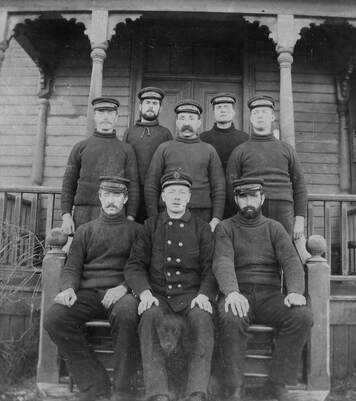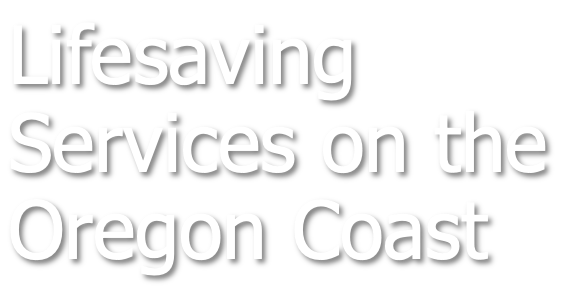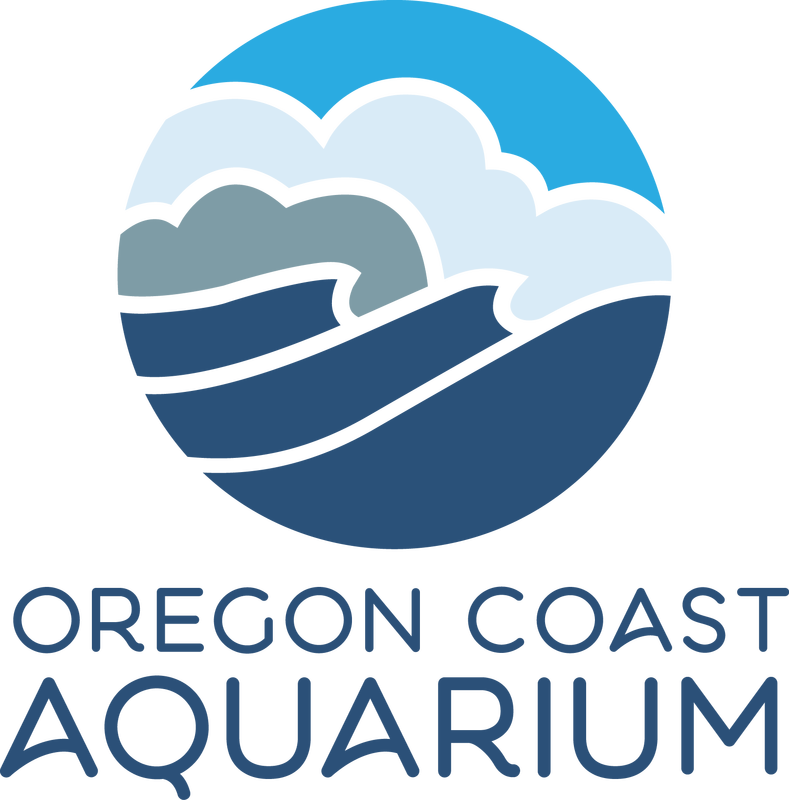 Newport's original lifesaving crew, circa 1896.
Newport's original lifesaving crew, circa 1896.
EXPERIENCE > SCIENCE TOOLS
On both coasts of the United States, lifesaving services have a long and distinguished history. The U.S. Lighthouse Service was one of the first institutions established by the young republic in 1789, a testament to just how important and dangerous sea travel was for Americans. Over the decades that followed, hundreds of lighthouses were established all along the Atlantic seaboard. Considerably fewer were established on the West Coast, due mostly to a lesser importance in commerce and a much smaller population.
In 1848, the United States Congress created the U.S. Lifesaving Service to supplement the work of the lighthouses. At first, the service did little but set up unmanned huts filled with provisions intended to help sailors who wrecked along the coast. If sailors actually survived the cold ocean waters and made it to one of the huts, they might find food and water waiting for them. But rescue was another issue altogether.
On both coasts of the United States, lifesaving services have a long and distinguished history. The U.S. Lighthouse Service was one of the first institutions established by the young republic in 1789, a testament to just how important and dangerous sea travel was for Americans. Over the decades that followed, hundreds of lighthouses were established all along the Atlantic seaboard. Considerably fewer were established on the West Coast, due mostly to a lesser importance in commerce and a much smaller population.
In 1848, the United States Congress created the U.S. Lifesaving Service to supplement the work of the lighthouses. At first, the service did little but set up unmanned huts filled with provisions intended to help sailors who wrecked along the coast. If sailors actually survived the cold ocean waters and made it to one of the huts, they might find food and water waiting for them. But rescue was another issue altogether.
Lights Along the Coast: A Newport historian shares the amazing and important history of Oregon's numerous lighthouses.
US Coast Guard: Watching the Waves: A US Coast Guardsman describes the life-saving role of this organization and provides tips on how to stay safe near the ocean.
US Coast Guard: Using Technology to Save Lives: Take a look at some of the sophisticated technology used by the United States Coast Guard to help save lives on the Oregon Coast.
It would be decades until the lifesaving services involved trained rescue crews using specialized boats and equipment to help stranded mariners. Manned lifesaving stations were also established along the Oregon Coast, usually as separate facilities from lighthouses. These stations usually included of “lookouts,” barracks and boathouses from which rescue vessels could be quickly dispatched.
In 1915, the Lifesaving Service was merged with the United States Revenue Cutter Service, a maritime law enforcement agency which had been established at about the same time. The new agency became known as the United States Coast Guard, a branch of the Treasury Department charged with protecting the coasts and coastal waters of the United States, enforce maritime law and affect rescues when needed. During the middle part of the twentieth century, particularly as the threat of war with Japan increased during the 1930s, many of the old Lifesaving Service facilities were abandoned and new posts were established by the Coast Guard. Coastal “lookout” areas were sometimes replaced with modern radar facilities or even gun emplacements to protect from the threat of submarines or sea-based invasion. In Oregon, the Coast Guard still occupies some of the same facilities built during World War II, including a station in Yaquina Bay near the Oregon Coast Aquarium.
Related Information: Lights Along the Coast | Suited Up To Survive |Yaquina Bay Lighthouse
Photo credits: Lincoln County Historical Society; United States Coast Guard, Station Yaquina Bay.
In 1915, the Lifesaving Service was merged with the United States Revenue Cutter Service, a maritime law enforcement agency which had been established at about the same time. The new agency became known as the United States Coast Guard, a branch of the Treasury Department charged with protecting the coasts and coastal waters of the United States, enforce maritime law and affect rescues when needed. During the middle part of the twentieth century, particularly as the threat of war with Japan increased during the 1930s, many of the old Lifesaving Service facilities were abandoned and new posts were established by the Coast Guard. Coastal “lookout” areas were sometimes replaced with modern radar facilities or even gun emplacements to protect from the threat of submarines or sea-based invasion. In Oregon, the Coast Guard still occupies some of the same facilities built during World War II, including a station in Yaquina Bay near the Oregon Coast Aquarium.
Related Information: Lights Along the Coast | Suited Up To Survive |Yaquina Bay Lighthouse
Photo credits: Lincoln County Historical Society; United States Coast Guard, Station Yaquina Bay.





